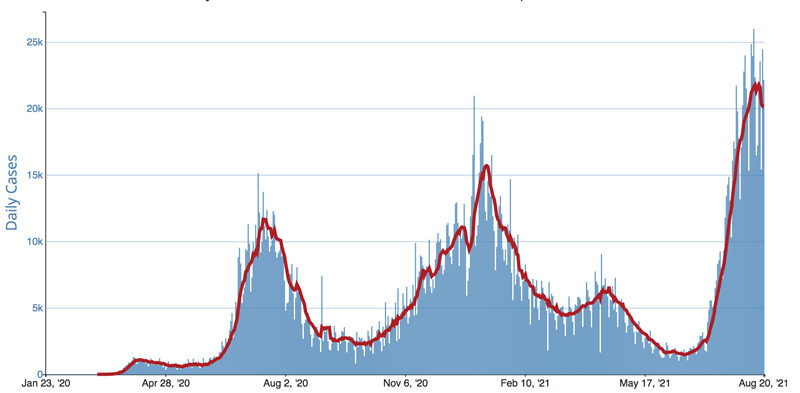Orange County COVID-19 Cases & Hospitalizations May Have Peaked
Here’s the weekly COVID-19 report with data from Orange County, Central Florida, and around Walt Disney World as of August 31, 2021. This provides an update on new cases, positivity, hospitalizations, etc., plus public health expert commentary, headlines that made news in the last week, and a correction to last week’s update that blunts some of the optimism.
As always, this information is assembled since it’s potentially relevant news to out-of-staters planning or on the fence about a vacation to Walt Disney World. The goal with these updates distilling data and information from multiple sources, free of hyperbole and sensationalism–just a straightforward report on current circumstances in Central Florida.
We’ll start with numbers from the CDC, which reported 13,022 new cases in Florida for August 29, 2021 (the most recent date for which there’s data). This might seem like a sharp decrease, but it’s from a Sunday, which typically sees lower numbers of new cases due to reduced testing center operating hours. Florida’s 7-day average of new cases currently stands at 21,288.
As of last week’s COVID-19 report, Florida’s 7-day moving average had decreased to 20,134. At the time, we called this reason for optimism, as no past wave has decreased and then increased shortly thereafter. (It appears that happened between Christmas and New Year’s, but that was because testing stations were closed for much/most of that holiday week.)
As a refresher, here was the graph as of last week:
Unfortunately, the Florida Department of Health revised its daily numbers upwards for the dates that previously showed a decline. This was a routine reporting delay, and no nefarious motivations should be ascribed to it–the same has happened throughout the pandemic elsewhere.
Here’s the current CDC new case graph, with data through August 29, 2021:
Florida has now had a 7-day moving average of new cases in the 21,000s every day since August 10, 2021.
The best explanation for this–and one that’s supported by data below–is that schools started going back into session that week. August 10 was Orange County’s first day of school and Osceola County also went back in session that same week, as did many other districts throughout Florida and the South.
Normally, hospitalizations lag cases. However, the Florida Hospital Association is reporting a decline in new hospitalizations. The total number of hospitalizations as of yesterday (August 30, 2021) was 15,488. This number is down 9.5% week-over-week, when it had already plateaued. While trending in the right direction, this is still near an all-time high.
Dr. Vincent Hsu, the hospital epidemiologist at AdventHealth, said their inpatient count in Central Florida was down to 1,386 people from its high of 1,725 during the current wave. (A hot topic on the local news last week was that AdventHealth and Orlando Health received refrigerated mobile morgues. This was fueled by the Delta variant, unvaccinated people, and backups at funeral homes.)
Per numbers from the Department of Health and Human Services, coronavirus patients accounted for 26.63% of Florida’s inpatient beds and 51.45% of ICU beds. In total, 84.85% of hospital beds in Florida are in use.
All of these numbers are down slightly week over week.
The weekly situation report from the Florida Department of Health can contextualize new cases holding steady while hospitalizations have dropped.
This report shows new cases dropping in the last the week among every age range except those under 19 years old, which is a continuation of the trend we’ve seen in recent weeks with increased testing in schools. The statistical likelihood of being hospitalized decreases along with age.
Again, over 80% of residents above the age of 60 are vaccinated, whereas less than half of those under age 30 are fully vaccinated. Weekly numbers also reflect an accelerated rate of vaccination among younger age cohorts.
Yesterday, Orange County held its latest health press conference, which you can view for yourself above. (As with the last couple of weeks, this one is not really worth watching.)
Orange County Mayor Jerry Demings began by sharing that “there’s good news, that the 14-day positivity rate has decreased to 17.86%. So it’s a promising sign that we have plateaued and the number of new cases are beginning to decline.” (Positivity rates had been stuck at ~20% for the last several weeks.)
Dr. Raul Pino from the Florida Department of Health in Orange County also spoke at the press conference, sharing a variety of data that indicates to him that Orange County peaked in week 32 (it’s now week 34). Both he and Mayor Demings struck cautiously optimistic tones.
Dr. Pino shared new data for Orange County, including that the 7-day positivity average was 16.1% for Orange County. He also stated that during the peak of the current wave, Orange County had 634 new cases per 100,000 people. Last week, the county was at 544 new cases per 100k.
On Sunday, Orange County reported 823 new cases, which is also down week over week. That same day, the positivity rate was 14.1%, a further decline from the 14-day and 7-day rolling averages. There were also 34 deaths in Orange County due to COVID in the last week, which the expectation that this number will continue increasing in early September due to the lag between new cases and deaths.
Dr. Pino stated that the group accounting for most new cases is those ages 5-14, which currently account for 19% or approximately 155 cases per day in Orange County. He said there has been negative growth in new cases for each of the last two weeks, except among school age children.
While the declining positivity rate is good to see, it’s worth noting that the CDC’s criteria for moving down to the moderate level (where face masks are no longer recommended indoors) is under 50 total new cases per 100,000 persons in the past 7 days and under 8% test positivity during the past 7 days.
In short, Orange County’s numbers are heading in the right direction, but are still very high as compared to CDC targets and where they were earlier this summer. It’s probably going to be another month or more before another change to Walt Disney World’s face mask rules.
Turning to the experts, former FDA commissioner and member of the Pfizer board Dr. Scott Gottlieb appeared on CBS Face the Nation Sunday. He spoke on the timeline for the pediatric vaccine, stating that Pfizer would file data with the FDA in September and then apply for authorization as early as October.
That means the vaccine could be available for kids in late fall or early winter, depending on how long FDA takes to review the application. Per Gottlieb, the vaccine could be authorized for kids ages 5 and up “at some point in November, late November, maybe early December” with vaccinations rolled out before the end of 2021.
Gottlieb also spoke about school reopenings, which is likely a topic of interest to many of you: “What we’re seeing in the South is very concerning. An epidemic that coursed its way through the adult population is now coursing its way through children, particularly as they re-enter school. There’s 300 kids a day being hospitalized around the country for COVID. If you look at some of the school districts down the south, Tampa…has 10,000 kids already diagnosed with COVID [since school reopened on August 10].”
“Schools need to look at what’s happening in the South and take adequate precautions. I don’t think that we should be going into the school year, lifting the mitigation that may have worked…we have to throw everything we can at this challenge of trying to keep the infection from becoming epidemic in the school setting. The Delta variant is very contagious. It spreads easily in that environment. The two best things that schools could be doing right now is frequent testing…and keeping students in geographic [or] social pods. Those two elements alone…are probably the two most effective steps schools can be taking. And then using masks and improving ventilation is also going to be very important. And finally, getting kids vaccinated, only about 50% of kids who are eligible to be vaccinated have been vaccinated.”
Looking forward, it’s worth noting that Florida colleges and universities are starting to begin their academic years, which health experts believe will contribute to new cases due to the lack of mitigation measures and lower vaccination rates among younger age groups. The new case numbers resulting from schools going back into session could prolong the plateau in Florida’s statewide data, even as hospitalizations and severe outcomes among more vulnerable populations drop.
As we shared last week, a couple of Florida universities have also been modeling the trajectory of the pandemic. Researchers from the University of Florida’s model predicted the peak as shown in the data among Florida’s non-school age population. Similarly, the University of South Florida’s computer model predicted a peak last week, and that Florida will likely reach herd immunity around September 11, 2021 due to the numbers of people who have been vaccinated and/or naturally infected. Neither one of these models forecast another holiday surge like the one occurring from around last Thanksgiving to New Year’s in Florida, with deaths ending and COVID eventually burning itself out.
Another thing to be expected is that a person’s COVID-19 antibody levels will decline over time. If they didn’t drop after every infection or vaccination, your blood would be as thick as sludge, full of antibodies from every pathogen to which you’ve ever been exposed.
High neutralizing-antibody levels shortly after inoculation are indicative of highly efficacious vaccines. However, when those antibody levels inevitably fall, you still have protection against severe disease due to durable immune memory of B and T cells. This is nuance that has been lost in the media’s breathless coverage about breakthrough cases and waning antibodies.
In plain English, durable and long-lasting population immunity will dramatically decrease severe outcomes in any future waves or flare ups that may emerge next year or beyond as COVID-19 becomes endemic. This recent piece in The Atlantic (which we highly recommend reading) discusses the need for Americans to recalibrate their expectations, as preventing all infections or eliminating the coronavirus is not a realistic goal. However, widespread vaccinations could turn COVID-19 into something more like influenza, with the key message that if you’re vaccinated, you’re well protected against life-threatening disease. In life, there is no such thing as eliminating risk–only mitigating it.
Planning a Walt Disney World trip? Learn about hotels on our Walt Disney World Hotels Reviews page. For where to eat, read our Walt Disney World Restaurant Reviews. To save money on tickets or determine which type to buy, read our Tips for Saving Money on Walt Disney World Tickets post. Our What to Pack for Disney Trips post takes a unique look at clever items to take. For what to do and when to do it, our Walt Disney World Ride Guides will help. For comprehensive advice, the best place to start is our Walt Disney World Trip Planning Guide for everything you need to know!











